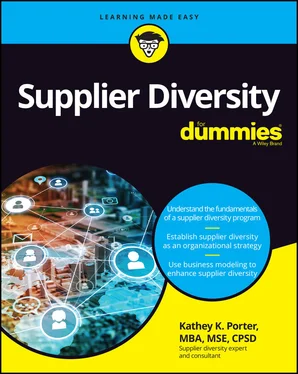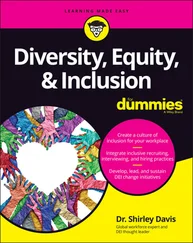Kathey K. Porter - Supplier Diversity For Dummies
Здесь есть возможность читать онлайн «Kathey K. Porter - Supplier Diversity For Dummies» — ознакомительный отрывок электронной книги совершенно бесплатно, а после прочтения отрывка купить полную версию. В некоторых случаях можно слушать аудио, скачать через торрент в формате fb2 и присутствует краткое содержание. Жанр: unrecognised, на английском языке. Описание произведения, (предисловие) а так же отзывы посетителей доступны на портале библиотеки ЛибКат.
- Название:Supplier Diversity For Dummies
- Автор:
- Жанр:
- Год:неизвестен
- ISBN:нет данных
- Рейтинг книги:4 / 5. Голосов: 1
-
Избранное:Добавить в избранное
- Отзывы:
-
Ваша оценка:
- 80
- 1
- 2
- 3
- 4
- 5
Supplier Diversity For Dummies: краткое содержание, описание и аннотация
Предлагаем к чтению аннотацию, описание, краткое содержание или предисловие (зависит от того, что написал сам автор книги «Supplier Diversity For Dummies»). Если вы не нашли необходимую информацию о книге — напишите в комментариях, мы постараемся отыскать её.
Supplier Diversity For Dummies,
Supplier Diversity For Dummies
Supplier Diversity For Dummies — читать онлайн ознакомительный отрывок
Ниже представлен текст книги, разбитый по страницам. Система сохранения места последней прочитанной страницы, позволяет с удобством читать онлайн бесплатно книгу «Supplier Diversity For Dummies», без необходимости каждый раз заново искать на чём Вы остановились. Поставьте закладку, и сможете в любой момент перейти на страницу, на которой закончили чтение.
Интервал:
Закладка:
This was a tipping point, where organizations began looking internally at how they could step up and support, putting supplier diversity squarely in the middle. With supplier diversity professionals, there was a renewed sense of urgency to create creative solutions that would have a lasting impact. Global organizations announced financial commitments, pledged resources, and opened their doors to diverse businesses like never before. The year 2021 was definitely a defining moment in supplier diversity work to get small and diverse businesses back to work.
Diving into Their Different Audiences, Tactics, and Results
As a department or even a strategic initiative, diversity programs are still relatively green when compared to other functions within an organization. Despite diversity’s auspicious start during the 1960s, for many years it languished and wasn’t always embraced, welcomed, or even understood. But during the 1970s and 1980s, it became clear that the focus on diversity wasn’t going away. Organizations had to quickly get intentional about their commitment, develop strategies that worked, and create programs that could have a lasting impact on their communities.
Understanding the key differences in supplier diversity and DEI programs helps you balance and use them collaboratively and complementarily to avoid hyperfocusing on one area and neglecting the other. The following sections break down a few of these major differences.
Customers/target audience
DEI focuses on recruiting and fostering a culture of inclusion for current and future employees regardless of ethnicity, gender, age, disability, sexual orientation, religion, nationality, or educational level. DEI may also focus on niche groups within the organization that may have historically been overlooked, such as parents that are adopting or fathers that want to take paternal leave. These groups have a tremendous voice in shaping the benefits that an organization offers its employees.
Supplier diversity focuses on developing and nurturing the contracting relationship with suppliers, vendors, and consultants that have been historically marginalized and excluded from business opportunities because of ethnicity, gender, sexual orientation, and veteran status.
Tactics used
Supplier diversity and DEI deploy different methods to appeal to their target audiences. Because internal feedback is so important to the culture-building process, DEI directs its efforts primarily in the internal environment. It may deploy a combination of methods including recruitment fairs, ERGs, and climate surveys to direct its program efforts.
Supplier diversity uses a combination of external and internal efforts to achieve its results. Because it’s targeting small and diverse businesses from the community, it participates in outreach events and conducts workshops and training, all directed at the external community. It may even use councils of external small and diverse businesses and other community stakeholders. Internally, it works with employees, senior leaders, and allies to help them understand supplier diversity and encourage them to buy from small and diverse vendors.
 Understanding the context of supplier diversity allows organizations to create a program that fits their cultures while addressing the issues of their small business communities.
Understanding the context of supplier diversity allows organizations to create a program that fits their cultures while addressing the issues of their small business communities.
Measuring results
DEI and supplier diversity use varying metrics to demonstrate their value and measure success. The types of instruments they use definitely overlap, but ultimately, it’s a bit like comparing apples to oranges. They’re both fruit, but they taste totally different.
 Understanding the differences in the types of metrics tracked by each program and the context of the information gathered is important. Combining metrics may not consider outliers or one-off scenarios that exist in supplier diversity. Focusing on the wrong metrics may make you overlook gaps in your program.
Understanding the differences in the types of metrics tracked by each program and the context of the information gathered is important. Combining metrics may not consider outliers or one-off scenarios that exist in supplier diversity. Focusing on the wrong metrics may make you overlook gaps in your program.
DEI may focus on the number of hires, efforts taken to accommodate specific groups, the number of new initiatives that recognize and celebrate different nationalities, the creation of programs that create a pipeline to senior leadership positions, and so on.
With supplier diversity, spend and utilization with small and diverse vendors are the most common metrics. And, for a long time, they were the standard metrics. With the heavy investment in supplier development, supplier diversity today may look at the number of small and diverse businesses responding to solicitations, the award and project completion rates for small and diverse business, the conversion rate for workshop attendees becoming actual vendors, the number of repeat awardees, whether contract awards are increasing or decreasing, and so on.
 In addition to their core metrics, both programs are looking for additional ways to capture and demonstrate their value by looking at the quality of life and economic impact investments in these programs are having on the community. Measuring diversity results is all about assessing success, identifying gaps to drive necessary behaviors, and determining corrective action to make the organization and these programs better.
In addition to their core metrics, both programs are looking for additional ways to capture and demonstrate their value by looking at the quality of life and economic impact investments in these programs are having on the community. Measuring diversity results is all about assessing success, identifying gaps to drive necessary behaviors, and determining corrective action to make the organization and these programs better.
Figure 4-1 provides examples of metrics used by each and shows how they compare to each other.

FIGURE 4-1:Differences in measuring results.
Becoming Collaborative Partners
Supplier diversity and DEI definitely have aspects that make them great collaborative partners. Based on their timelines and history, in many ways DEI and supplier diversity have grown together. Each started by government executive order, with little guidance other than the intended outcome. Unfortunately, the path to get there was never completely laid out. Through trial and error, both programs have had to figure out their respective roles and how best to deliver value to the organizations.
Based on the differences I describe in the earlier section “ Diving into Their Different Audiences, Tactics, and Results,” each has forged a distinct path and role — DEI in HR and supplier diversity in procurement — and both have managed to grow and become strategic staples by working together as natural collaborative partners.
 In Chapter 8, I discuss the relationship between supplier diversity and DEI; for the purposes of this chapter, you should understand the three ways in which supplier diversity and DEI collaborate:
In Chapter 8, I discuss the relationship between supplier diversity and DEI; for the purposes of this chapter, you should understand the three ways in which supplier diversity and DEI collaborate:
Help gain active stakeholder involvement
Help increase visibility and engagement across the organization
Help keep the diversity conversation top of mind
Perusing the Pitfalls of Combining Supplier Diversity and DEI
In recent years, two trends have appeared to sometimes blur the line between supplier diversity and DEI. Understandably, how your diversity efforts are structured depends on budget, personnel, or exactly how your organization views diversity. Whatever the reason, it should align with what your organization wants to accomplish and how you want the public and your stakeholders to perceive your diversity efforts. But in this setting, for the two programs to exist without one cannibalizing the other is a challenge. The following sections cover some of the current trends and the problems they present.
Читать дальшеИнтервал:
Закладка:
Похожие книги на «Supplier Diversity For Dummies»
Представляем Вашему вниманию похожие книги на «Supplier Diversity For Dummies» списком для выбора. Мы отобрали схожую по названию и смыслу литературу в надежде предоставить читателям больше вариантов отыскать новые, интересные, ещё непрочитанные произведения.
Обсуждение, отзывы о книге «Supplier Diversity For Dummies» и просто собственные мнения читателей. Оставьте ваши комментарии, напишите, что Вы думаете о произведении, его смысле или главных героях. Укажите что конкретно понравилось, а что нет, и почему Вы так считаете.












